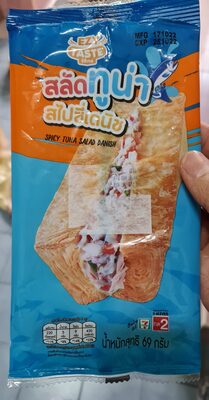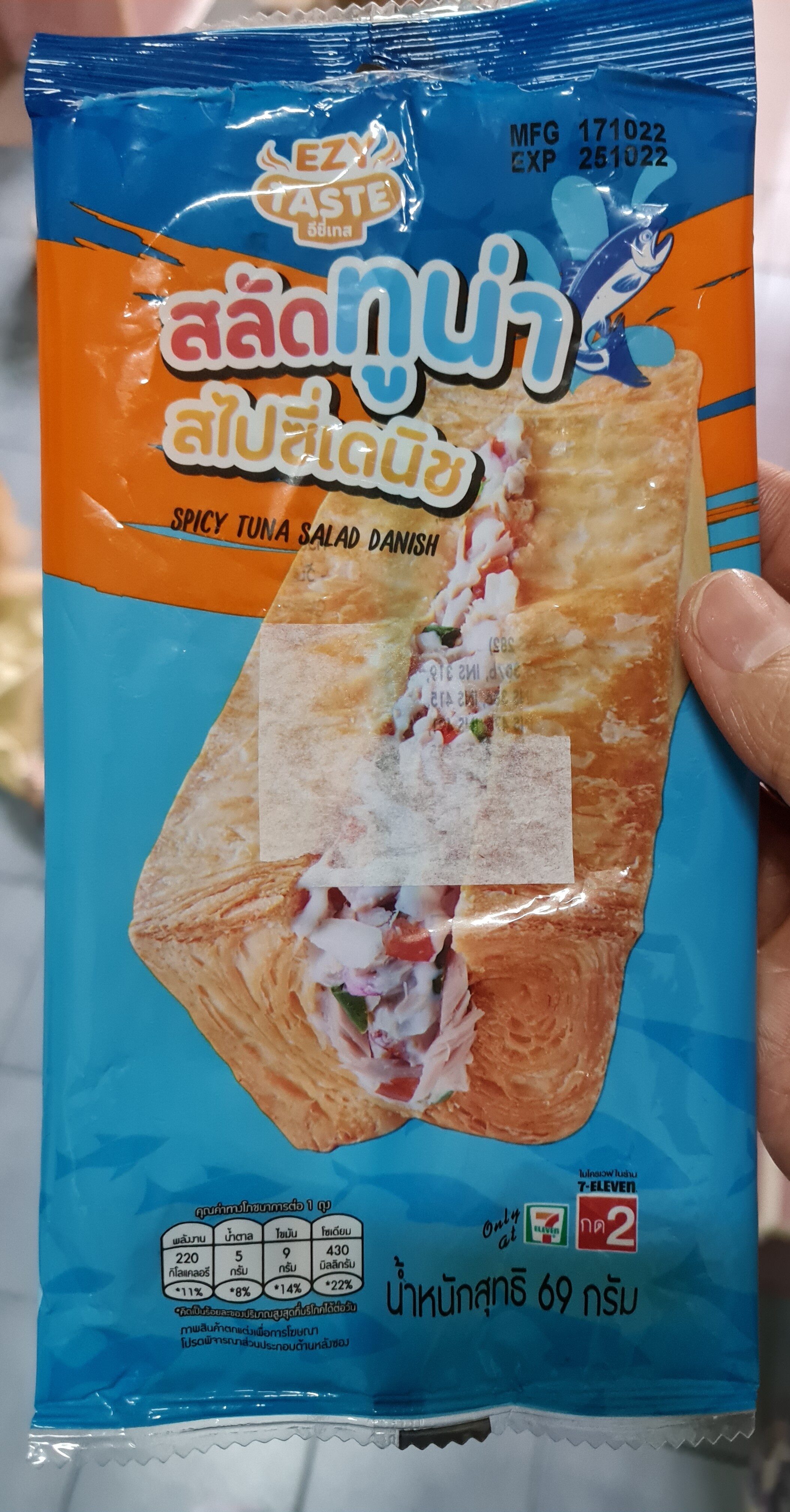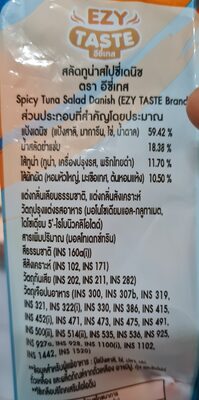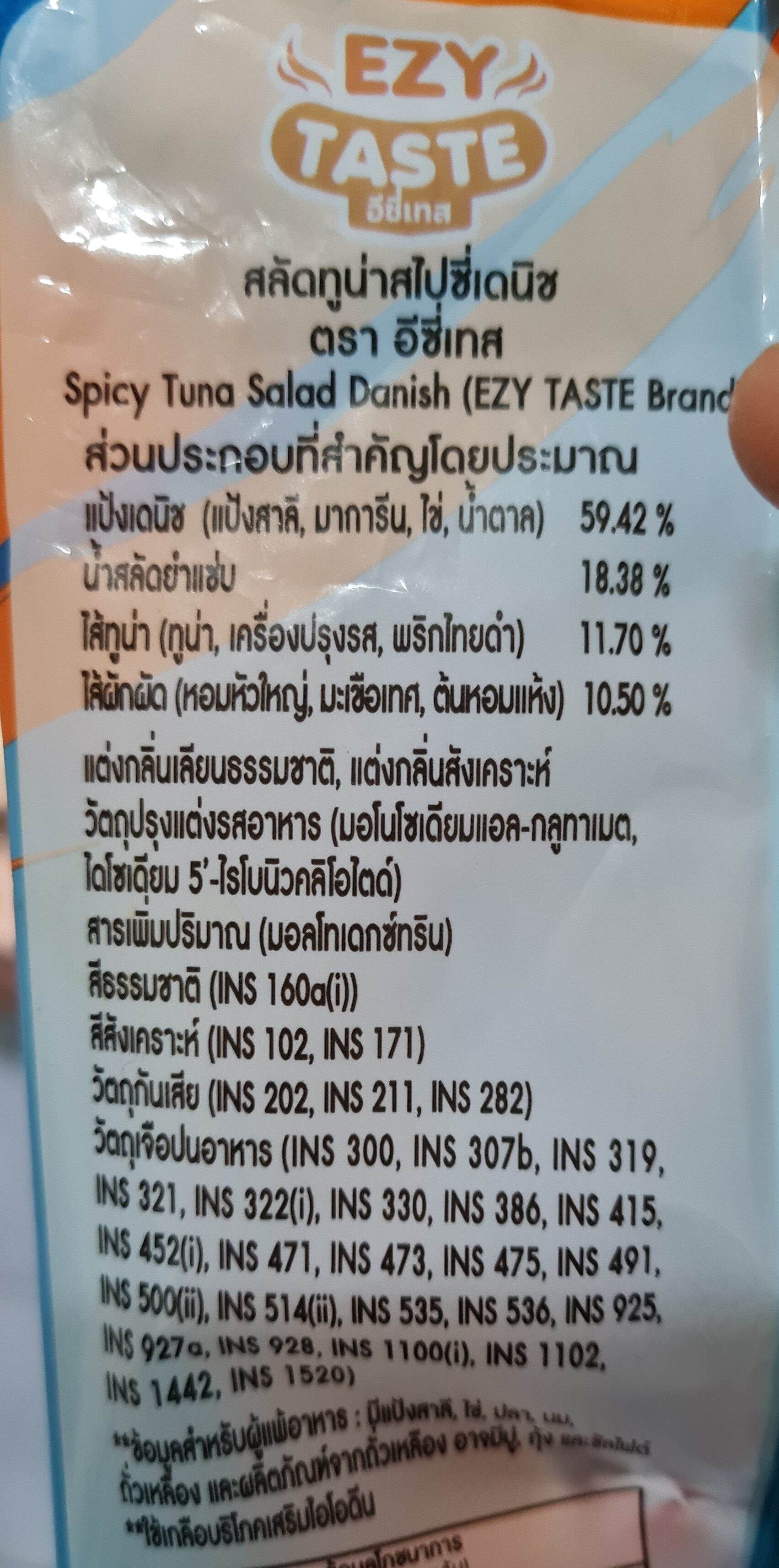Help us make food transparency the norm!
As a non-profit organization, we depend on your donations to continue informing consumers around the world about what they eat.
The food revolution starts with you!
สลัดทูน่า สไปซี่เดนิช - EzyTaste - 69 g
สลัดทูน่า สไปซี่เดนิช - EzyTaste - 69 g
This product page is not complete. You can help to complete it by editing it and adding more data from the photos we have, or by taking more photos using the app for Android or iPhone/iPad. Thank you!
×
Barcode: 8858867817093 (EAN / EAN-13)
Quantity: 69 g
Packaging: Pack
Brands: EzyTaste
Categories: Sandwich tuna
Countries where sold: Thailand
Matching with your preferences
Health
Ingredients
-
53 ingredients
: แป้งเดนิช (แป้งสาลี, มาการีน, ไข่, น้ำตาล) 59.42% น้ำสลัดย่าแช่น 18.38 %ไส้ทูน่า (ทูน่า, เครื่องปรุงรส, พริกไทยดำ) 10.50 % ไส้ผักผิด (หอมหัวใหญ่, มะเขือเทศ, ต้นหอมแห้ง) 11.70 % แต่งกลิ่นเลียนธรรมชาติ, แต่งกลิ่นสังเคราะห์ วัตถุปรุงแต่งรสอาหาร (มอโนโซเดียมแอล-กลูทาเมต ไดโซเดียม 5'-ไรโบนิวคลีโอไตด์) สารเพิ่มปริมาณ (มอลโทเดกซ์ทริน) สีธรรมชาติ (INS 160a(i)) สีสังเคราะห์ (INS 102, INS 171) วัตถุกันเสีย (INS 202, INS 211, INS 282) วัตถุเจือปนอาหาร (INS 300, INS 3075, INS 319, INS 321, INS 322(1), INS 330, INS 386, INS 415, INS 452(i), INS 471, INS 473, INS 475, INS 491, INS 500(i), INS 514(i), INS 535, INS 536, INS 925, INS 927, INS 928, INS 1100(i), INS 102, INS 1442, INS 1520)Allergens: Crustaceans, Eggs, Fish, Gluten, Milk, Soybeans, Sulphur dioxide and sulphitesTraces: Eggs
Food processing
-
Ultra processed foods
Elements that indicate the product is in the 4 - Ultra processed food and drink products group:
- Additive: E102 - Tartrazine
- Additive: E1442 - Hydroxypropyl distarch phosphate
- Additive: E322 - Lecithins
- Additive: E415 - Xanthan gum
- Additive: E452 - Polyphosphates
- Additive: E471 - Mono- and diglycerides of fatty acids
- Additive: E473 - Sucrose esters of fatty acids
- Additive: E475 - Polyglycerol esters of fatty acids
- Additive: E491 - Sorbitan monostearate
Food products are classified into 4 groups according to their degree of processing:
- Unprocessed or minimally processed foods
- Processed culinary ingredients
- Processed foods
- Ultra processed foods
The determination of the group is based on the category of the product and on the ingredients it contains.
Additives
-
E102 - Tartrazine
Tartrazine: Tartrazine is a synthetic lemon yellow azo dye primarily used as a food coloring. It is also known as E number E102, C.I. 19140, FD&C Yellow 5, Acid Yellow 23, Food Yellow 4, and trisodium 1--4-sulfonatophenyl--4--4-sulfonatophenylazo--5-pyrazolone-3-carboxylate-.Tartrazine is a commonly used color all over the world, mainly for yellow, and can also be used with Brilliant Blue FCF -FD&C Blue 1, E133- or Green S -E142- to produce various green shades.Source: Wikipedia
-
E1442 - Hydroxypropyl distarch phosphate
Hydroxypropyl distarch phosphate: Hydroxypropyl distarch phosphate -HDP- is a modified resistant starch. It is currently used as a food additive -INS number 1442-. It is approved for use in the European Union -listed as E1442-, the United States, Australia, Taiwan, and New Zealand.Source: Wikipedia
-
E202 - Potassium sorbate
Potassium sorbate (E202) is a synthetic food preservative commonly used to extend the shelf life of various food products.
It works by inhibiting the growth of molds, yeast, and some bacteria, preventing spoilage. When added to foods, it helps maintain their freshness and quality.
Some studies have shown that when combined with nitrites, potassium sorbate have genotoxic activity in vitro. However, potassium sorbate is generally recognized as safe (GRAS) by regulatory authorities.
-
E211 - Sodium benzoate
Sodium benzoate: Sodium benzoate is a substance which has the chemical formula NaC7H5O2. It is a widely used food preservative, with an E number of E211. It is the sodium salt of benzoic acid and exists in this form when dissolved in water. It can be produced by reacting sodium hydroxide with benzoic acid.Source: Wikipedia
-
E319 - Tertiary-butylhydroquinone (tbhq)
Tert-Butylhydroquinone: tert-Butylhydroquinone -TBHQ, tertiary butylhydroquinone- is a synthetic aromatic organic compound which is a type of phenol. It is a derivative of hydroquinone, substituted with a tert-butyl group.Source: Wikipedia
-
E321 - Butylated hydroxytoluene
Butylated hydroxytoluene: Butylated hydroxytoluene -BHT-, also known as dibutylhydroxytoluene, is a lipophilic organic compound, chemically a derivative of phenol, that is useful for its antioxidant properties. European and U.S. regulations allow small amounts to be used as a food additive. In addition to this use, BHT is widely used to prevent oxidation in fluids -e.g. fuel, oil- and other materials where free radicals must be controlled.Source: Wikipedia
-
E322 - Lecithins
Lecithins are natural compounds commonly used in the food industry as emulsifiers and stabilizers.
Extracted from sources like soybeans and eggs, lecithins consist of phospholipids that enhance the mixing of oil and water, ensuring smooth textures in various products like chocolates, dressings, and baked goods.
They do not present any known health risks.
-
E330 - Citric acid
Citric acid is a natural organic acid found in citrus fruits such as lemons, oranges, and limes.
It is widely used in the food industry as a flavor enhancer, acidulant, and preservative due to its tart and refreshing taste.
Citric acid is safe for consumption when used in moderation and is considered a generally recognized as safe (GRAS) food additive by regulatory agencies worldwide.
-
E415 - Xanthan gum
Xanthan gum (E415) is a natural polysaccharide derived from fermented sugars, often used in the food industry as a thickening and stabilizing agent.
This versatile food additive enhances texture and prevents ingredient separation in a wide range of products, including salad dressings, sauces, and gluten-free baked goods.
It is considered safe for consumption even at high intake amounts.
-
E471 - Mono- and diglycerides of fatty acids
Mono- and diglycerides of fatty acids (E471), are food additives commonly used as emulsifiers in various processed foods.
These compounds consist of glycerol molecules linked to one or two fatty acid chains, which help stabilize and blend water and oil-based ingredients. E471 enhances the texture and shelf life of products like margarine, baked goods, and ice cream, ensuring a smooth and consistent texture.
It is generally considered safe for consumption within established regulatory limits.
-
E491 - Sorbitan monostearate
Sorbitan monostearate: Sorbitan monostearate is an ester of sorbitan -a sorbitol derivative- and stearic acid and is sometimes referred to as a synthetic wax. It is primarily used as an emulsifier to keep water and oils mixed. Sorbitan monostearate is used in the manufacture of food and healthcare products and is a non-ionic surfactant with emulsifying, dispersing, and wetting properties. It is also employed to create synthetic fibers, metal machining fluid, and brighteners in the leather industry, and as an emulsifier in coatings, pesticides, and various applications in the plastics, food and cosmetics industries. Sorbitans are also known as "Spans". Sorbitan monostearate has been approved by the European Union for use as a food additive -emulsifier- -E number: E 491-Source: Wikipedia
-
E500 - Sodium carbonates
Sodium carbonates (E500) are compounds commonly used in food preparation as leavening agents, helping baked goods rise by releasing carbon dioxide when they interact with acids.
Often found in baking soda, they regulate the pH of food, preventing it from becoming too acidic or too alkaline. In the culinary world, sodium carbonates can also enhance the texture and structure of foods, such as noodles, by modifying the gluten network.
Generally recognized as safe, sodium carbonates are non-toxic when consumed in typical amounts found in food.
-
E500i - Sodium carbonate
Sodium carbonate: Sodium carbonate, Na2CO3, -also known as washing soda, soda ash and soda crystals, and in the monohydrate form as crystal carbonate- is the water-soluble sodium salt of carbonic acid. It most commonly occurs as a crystalline decahydrate, which readily effloresces to form a white powder, the monohydrate. Pure sodium carbonate is a white, odorless powder that is hygroscopic -absorbs moisture from the air-. It has a strongly alkaline taste, and forms a moderately basic solution in water. Sodium carbonate is well known domestically for its everyday use as a water softener. Historically it was extracted from the ashes of plants growing in sodium-rich soils, such as vegetation from the Middle East, kelp from Scotland and seaweed from Spain. Because the ashes of these sodium-rich plants were noticeably different from ashes of timber -used to create potash-, they became known as "soda ash". It is synthetically produced in large quantities from salt -sodium chloride- and limestone by a method known as the Solvay process. The manufacture of glass is one of the most important uses of sodium carbonate. Sodium carbonate acts as a flux for silica, lowering the melting point of the mixture to something achievable without special materials. This "soda glass" is mildly water-soluble, so some calcium carbonate is added to the melt mixture to make the glass produced insoluble. This type of glass is known as soda lime glass: "soda" for the sodium carbonate and "lime" for the calcium carbonate. Soda lime glass has been the most common form of glass for centuries. Sodium carbonate is also used as a relatively strong base in various settings. For example, it is used as a pH regulator to maintain stable alkaline conditions necessary for the action of the majority of photographic film developing agents. It acts as an alkali because when dissolved in water, it dissociates into the weak acid: carbonic acid and the strong alkali: sodium hydroxide. This gives sodium carbonate in solution the ability to attack metals such as aluminium with the release of hydrogen gas.It is a common additive in swimming pools used to raise the pH which can be lowered by chlorine tablets and other additives which contain acids. In cooking, it is sometimes used in place of sodium hydroxide for lyeing, especially with German pretzels and lye rolls. These dishes are treated with a solution of an alkaline substance to change the pH of the surface of the food and improve browning. In taxidermy, sodium carbonate added to boiling water will remove flesh from the bones of animal carcasses for trophy mounting or educational display. In chemistry, it is often used as an electrolyte. Electrolytes are usually salt-based, and sodium carbonate acts as a very good conductor in the process of electrolysis. In addition, unlike chloride ions, which form chlorine gas, carbonate ions are not corrosive to the anodes. It is also used as a primary standard for acid-base titrations because it is solid and air-stable, making it easy to weigh accurately.Source: Wikipedia
-
E514 - Sodium sulphates
Sodium sulfate: Sodium sulfate -also known as sodium sulphate or sulfate of soda- is the inorganic compound with formula Na2SO4 as well as several related hydrates. All forms are white solids that are highly soluble in water. With an annual production of 6 million tonnes, the decahydrate is a major commodity chemical product. It is mainly used for the manufacture of detergents and in the kraft process of paper pulping.Source: Wikipedia
-
E514i - Sodium sulphate
Sodium sulfate: Sodium sulfate -also known as sodium sulphate or sulfate of soda- is the inorganic compound with formula Na2SO4 as well as several related hydrates. All forms are white solids that are highly soluble in water. With an annual production of 6 million tonnes, the decahydrate is a major commodity chemical product. It is mainly used for the manufacture of detergents and in the kraft process of paper pulping.Source: Wikipedia
-
E535 - Sodium ferrocyanide
Sodium ferrocyanide: Sodium ferrocyanide is the sodium salt of the coordination compound of formula [Fe-CN-6]4−. In its hydrous form, Na4Fe-CN-6 · 10 H2O -sodium ferrocyanide decahydrate-, it is sometimes known as yellow prussiate of soda. It is a yellow crystalline solid that is soluble in water and insoluble in alcohol. The yellow color is the color of ferrocyanide anion. Despite the presence of the cyanide ligands, sodium ferrocyanide has low toxicity -acceptable daily intake 0–0.025 mg/kg body weight-. The ferrocyanides are less toxic than many salts of cyanide, because they tend not to release free cyanide. However, like all ferrocyanide salt solutions, addition of an acid can result in the production of hydrogen cyanide gas, which is toxic.Source: Wikipedia
-
E536 - Potassium ferrocyanide
Potassium ferrocyanide: Potassium ferrocyanide is the inorganic compound with formula K4[Fe-CN-6]·3H2O. It is the potassium salt of the coordination complex [Fe-CN-6]4−. This salt forms lemon-yellow monoclinic crystals.Source: Wikipedia
-
E928 - Benzole peroxide
Benzoyl peroxide: Benzoyl peroxide -BPO- is a medication and industrial chemical. As a medication it is used to treat mild to moderate acne. For more severe cases it may be used together with other treatments. Some versions come mixed with antibiotics such as clindamycin. Other uses include bleaching flour, hair bleaching, teeth whitening, and textile bleaching. It is also used in the plastic industry.Common side effects are skin irritation, dryness, or peeling. Use in pregnancy is of unclear safety. Benzoyl peroxide is in the peroxide family of chemicals. When used for acne it works by killing bacteria.Benzoyl peroxide was first made in 1905 and came into medical use in the 1930s. It is on the World Health Organization's List of Essential Medicines, the most effective and safe medicines needed in a health system. Benzoyl peroxide is available as a generic medication and over the counter. In the United Kingdom 150 ml of a 10% solution costs the NHS about £4. In the United States a month of treatment costs less than US$25.Source: Wikipedia
Ingredients analysis
-
May contain palm oil
Ingredients that may contain palm oil: E160ai, E471
-
Non-vegan
Non-vegan ingredients: EggSome ingredients could not be recognized.
We need your help!
You can help us recognize more ingredients and better analyze the list of ingredients for this product and others:
- Edit this product page to correct spelling mistakes in the ingredients list, and/or to remove ingredients in other languages and sentences that are not related to the ingredients.
- Add new entries, synonyms or translations to our multilingual lists of ingredients, ingredient processing methods, and labels.
If you would like to help, join the #ingredients channel on our Slack discussion space and/or learn about ingredients analysis on our wiki. Thank you!
-
Vegetarian status unknown
Unrecognized ingredients: th:แป้งเดนิช, th:มาการีน, th:น้ำสลัดย่าแช่น-18-38-ไส้ทูน่า, th:ทูน่า, th:เครื่องปรุงรส, th:พริกไทยดำ, th:ไส้ผักผิด, th:หอมหัวใหญ่, th:ต้นหอมแห้ง, th:แต่งกลิ่นเลียนธรรมชาติ, th:แต่งกลิ่นสังเคราะห์-วัตถุปรุงแต่งรสอาหาร, th:มอโนโซเดียมแอล-กลูทาเมต-ไดโซเดียม-5-ไรโบนิวคลีโอไตด์, th:สารเพิ่มปริมาณ, th:มอลโทเดกซ์ทริน, th:สีธรรมชาติ, th:สีสังเคราะห์, th:วัตถุกันเสีย, th:วัตถุเจือปนอาหาร, th:e3075, th:1, E514i, th:e1100iSome ingredients could not be recognized.
We need your help!
You can help us recognize more ingredients and better analyze the list of ingredients for this product and others:
- Edit this product page to correct spelling mistakes in the ingredients list, and/or to remove ingredients in other languages and sentences that are not related to the ingredients.
- Add new entries, synonyms or translations to our multilingual lists of ingredients, ingredient processing methods, and labels.
If you would like to help, join the #ingredients channel on our Slack discussion space and/or learn about ingredients analysis on our wiki. Thank you!
-
Details of the analysis of the ingredients
We need your help!
Some ingredients could not be recognized.
We need your help!
You can help us recognize more ingredients and better analyze the list of ingredients for this product and others:
- Edit this product page to correct spelling mistakes in the ingredients list, and/or to remove ingredients in other languages and sentences that are not related to the ingredients.
- Add new entries, synonyms or translations to our multilingual lists of ingredients, ingredient processing methods, and labels.
If you would like to help, join the #ingredients channel on our Slack discussion space and/or learn about ingredients analysis on our wiki. Thank you!
: แป้งเดนิช (แป้งสาลี, มาการีน, ไข่, น้ำตาล), น้ำสลัดย่าแช่น 18.38 %ไส้ทูน่า 59.42% (ทูน่า, เครื่องปรุงรส, พริกไทยดำ), ไส้ผักผิด 10.5% (หอมหัวใหญ่, มะเขือเทศ, ต้นหอมแห้ง), แต่งกลิ่นเลียนธรรมชาติ 11.7%, แต่งกลิ่นสังเคราะห์ วัตถุปรุงแต่งรสอาหาร (มอโนโซเดียมแอล-กลูทาเมต ไดโซเดียม 5'-ไรโบนิวคลีโอไตด์), สารเพิ่มปริมาณ (มอลโทเดกซ์ทริน), สีธรรมชาติ (e160ai), สีสังเคราะห์ (e102, e171), วัตถุกันเสีย (e202, e211, e282), วัตถุเจือปนอาหาร (e300, e3075, e319, e321, e322 (1), e330, e386, e415, e452i, e471, e473, e475, e491, e500i, e514i, e535, e536, e925, e927, e928, e1100i, e102, e1442, e1520)- แป้งเดนิช -> th:แป้งเดนิช
- แป้งสาลี -> en:wheat-flour - vegan: yes - vegetarian: yes - ciqual_proxy_food_code: 9410
- มาการีน -> th:มาการีน
- ไข่ -> en:egg - vegan: no - vegetarian: yes - ciqual_food_code: 22000
- น้ำตาล -> en:sugar - vegan: yes - vegetarian: yes - ciqual_proxy_food_code: 31016
- น้ำสลัดย่าแช่น 18.38 %ไส้ทูน่า -> th:น้ำสลัดย่าแช่น-18-38-ไส้ทูน่า - percent: 59.42
- ทูน่า -> th:ทูน่า
- เครื่องปรุงรส -> th:เครื่องปรุงรส
- พริกไทยดำ -> th:พริกไทยดำ
- ไส้ผักผิด -> th:ไส้ผักผิด - percent: 10.5
- หอมหัวใหญ่ -> th:หอมหัวใหญ่
- มะเขือเทศ -> en:tomato - vegan: yes - vegetarian: yes - ciqual_food_code: 20047
- ต้นหอมแห้ง -> th:ต้นหอมแห้ง
- แต่งกลิ่นเลียนธรรมชาติ -> th:แต่งกลิ่นเลียนธรรมชาติ - percent: 11.7
- แต่งกลิ่นสังเคราะห์ วัตถุปรุงแต่งรสอาหาร -> th:แต่งกลิ่นสังเคราะห์-วัตถุปรุงแต่งรสอาหาร
- มอโนโซเดียมแอล-กลูทาเมต ไดโซเดียม 5'-ไรโบนิวคลีโอไตด์ -> th:มอโนโซเดียมแอล-กลูทาเมต-ไดโซเดียม-5-ไรโบนิวคลีโอไตด์
- สารเพิ่มปริมาณ -> th:สารเพิ่มปริมาณ
- มอลโทเดกซ์ทริน -> th:มอลโทเดกซ์ทริน
- สีธรรมชาติ -> th:สีธรรมชาติ
- e160ai -> en:e160ai - vegan: maybe - vegetarian: maybe - from_palm_oil: maybe
- สีสังเคราะห์ -> th:สีสังเคราะห์
- e102 -> en:e102 - vegan: yes - vegetarian: yes
- e171 -> en:e171 - vegan: yes - vegetarian: yes
- วัตถุกันเสีย -> th:วัตถุกันเสีย
- e202 -> en:e202 - vegan: yes - vegetarian: yes
- e211 -> en:e211 - vegan: yes - vegetarian: yes
- e282 -> en:e282 - vegan: yes - vegetarian: yes
- วัตถุเจือปนอาหาร -> th:วัตถุเจือปนอาหาร
- e300 -> en:e300 - vegan: yes - vegetarian: yes
- e3075 -> th:e3075
- e319 -> en:e319 - vegan: yes - vegetarian: yes
- e321 -> en:e321 - vegan: yes - vegetarian: yes
- e322 -> en:e322 - vegan: maybe - vegetarian: maybe
- 1 -> th:1
- e330 -> en:e330 - vegan: yes - vegetarian: yes
- e386 -> en:e386 - vegan: yes - vegetarian: yes
- e415 -> en:e415 - vegan: yes - vegetarian: yes
- e452i -> en:e452i - vegan: yes - vegetarian: yes
- e471 -> en:e471 - vegan: maybe - vegetarian: maybe - from_palm_oil: maybe
- e473 -> en:e473 - vegan: maybe - vegetarian: maybe
- e475 -> en:e475 - vegan: maybe - vegetarian: maybe
- e491 -> en:e491 - vegan: maybe - vegetarian: maybe
- e500i -> en:e500i - vegan: yes - vegetarian: yes
- e514i -> en:e514i
- e535 -> en:e535 - vegan: yes - vegetarian: yes
- e536 -> en:e536 - vegan: yes - vegetarian: yes
- e925 -> en:e925 - vegan: yes - vegetarian: yes
- e927 -> en:e927 - vegan: yes - vegetarian: yes
- e928 -> en:e928 - vegan: yes - vegetarian: yes
- e1100i -> th:e1100i
- e102 -> en:e102 - vegan: yes - vegetarian: yes
- e1442 -> en:e1442 - vegan: yes - vegetarian: yes
- e1520 -> en:e490 - vegan: yes - vegetarian: yes
Nutrition
-
Poor nutritional quality
⚠ ️Warning: the amount of fruits, vegetables and nuts is not specified on the label, it was estimated from the list of ingredients: 0This product is not considered a beverage for the calculation of the Nutri-Score.
Positive points: 3
- Proteins: 5 / 5 (value: 10.1, rounded value: 10.1)
- Fiber: 3 / 5 (value: 2.9, rounded value: 2.9)
- Fruits, vegetables, nuts, and colza/walnut/olive oils: 0 / 5 (value: 0, rounded value: 0)
Negative points: 15
- Energy: 3 / 10 (value: 1330, rounded value: 1330)
- Sugars: 1 / 10 (value: 7.25, rounded value: 7.25)
- Saturated fat: 5 / 10 (value: 5.8, rounded value: 5.8)
- Sodium: 6 / 10 (value: 623, rounded value: 623)
The points for proteins are not counted because the negative points are greater or equal to 11.
Nutritional score: (15 - 3)
Nutri-Score:
-
Nutrient levels
-
Fat in moderate quantity (13%)
What you need to know- A high consumption of fat, especially saturated fats, can raise cholesterol, which increases the risk of heart diseases.
Recommendation: Limit the consumption of fat and saturated fat- Choose products with lower fat and saturated fat content.
-
Saturated fat in high quantity (5.8%)
What you need to know- A high consumption of fat, especially saturated fats, can raise cholesterol, which increases the risk of heart diseases.
Recommendation: Limit the consumption of fat and saturated fat- Choose products with lower fat and saturated fat content.
-
Sugars in moderate quantity (7.25%)
What you need to know- A high consumption of sugar can cause weight gain and tooth decay. It also augments the risk of type 2 diabetes and cardio-vascular diseases.
Recommendation: Limit the consumption of sugar and sugary drinks- Sugary drinks (such as sodas, fruit beverages, and fruit juices and nectars) should be limited as much as possible (no more than 1 glass a day).
- Choose products with lower sugar content and reduce the consumption of products with added sugars.
-
Salt in high quantity (1.56%)
What you need to know- A high consumption of salt (or sodium) can cause raised blood pressure, which can increase the risk of heart disease and stroke.
- Many people who have high blood pressure do not know it, as there are often no symptoms.
- Most people consume too much salt (on average 9 to 12 grams per day), around twice the recommended maximum level of intake.
Recommendation: Limit the consumption of salt and salted food- Reduce the quantity of salt used when cooking, and don't salt again at the table.
- Limit the consumption of salty snacks and choose products with lower salt content.
-
-
Nutrition facts
Nutrition facts As sold
for 100 g / 100 mlAs sold
per serving (69 g)Energy 1,330 kj
(319 kcal)920.48 kj
(220 kcal)Fat 13 g 9 g Saturated fat 5.8 g 4 g Trans fat 0 g 0 g Cholesterol 50.7 mg 35 mg Carbohydrates 39.1 g 27 g Sugars 7.25 g 5 g Fiber 2.9 g 2 g Proteins 10.1 g 7 g Salt 1.56 g 1.075 g Vitamin A 0 µg 0 µg (0 % DV) Vitamin B1 (Thiamin) 0.07 mg 0.048 mg (4 % DV) Vitamin B2 (Riboflavin) 0.049 mg 0.034 mg (2 % DV) Calcium 58 mg 40 mg (4 % DV) Iron 1.04 mg 0.72 mg (4 % DV) Fruits‚ vegetables‚ nuts and rapeseed‚ walnut and olive oils (estimate from ingredients list analysis) 0 % 0 %
Environment
-
Eco-Score not computed - Unknown environmental impact
We could not compute the Eco-Score of this product as it is missing some data, could you help complete it?Could you add a precise product category so that we can compute the Eco-Score? Add a category
Packaging
-
Missing packaging information for this product
⚠ ️ The information about the packaging of this product is not filled in.Take a photo of the recycling information Take a photo of the recycling information
Transportation
-
Origins of ingredients
Missing origins of ingredients information
⚠ ️ The origins of the ingredients of this product are not indicated.
If they are indicated on the packaging, you can modify the product sheet and add them.
If you are the manufacturer of this product, you can send us the information with our free platform for producers.Add the origins of ingredients for this product Add the origins of ingredients for this product
Report a problem
-
Incomplete or incorrect information?
Category, labels, ingredients, allergens, nutritional information, photos etc.
If the information does not match the information on the packaging, please complete or correct it. Open Food Facts is a collaborative database, and every contribution is useful for all.










